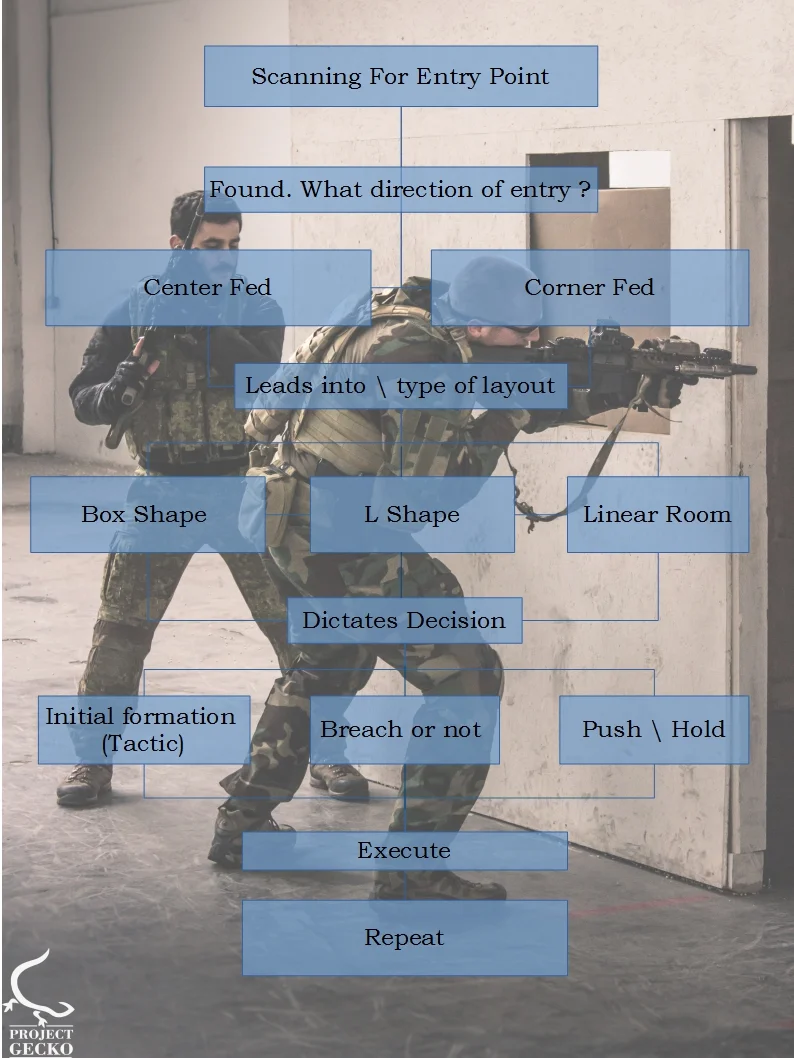Article One: The Anatomy of the Room Part 1
During our CQB coursesat Project gecko, especially in the entry level - we dedicate lot of time into definitions & structure recognition. our friend Rye from CQBTEAM joins up our CQB Education project, and shares his point of view.
Anatomy is a branch of science concerned with the structure of living organisms. When we look at the structure of a room there is not really a whole lot to see. That is until you begin to imagine it from the eyes of a soldier or police officer. Room structure dictates the way one may enter and clear the room. This article will look to break down the room into critical segments and describe their tactical significance , giving the reader a unique look into what rooms are to someone working within a tactical environment. The anatomy of a room .
Let’s start off with some simple concepts. The first concept we will examine differentiates the placement of an opening to the room. One opening is found in, or closest to, the center of a room and one opening is found on the corner of a room. One is a centerfed room and the other is a cornerfed room. An opening can be anything from an artificial hole created by an explosive or other means, a doorway or a window. As long as you can fit in it and make it into the entry point, that opening is the first vision of what could be inside the room.
Now you may be wondering what difference does this make? As we slowly expand into more concepts they will interconnect and you will see that simple delineations lead to a clearer understanding of the tactical environment. In fact, they can be the difference between life and death as I will demonstrate to you later in this series. So, what next? Now we have the door or opening placement worked out let’s look at the type of rooms you may encounter. For simplicities sake we will examine three simple structures: the boxshaped room , the linear room and the Lshaped room .
The boxshaped room can be simply called a box room. It is usually a square shaped room with four corners. This is the most common type of room we encounter within tactical training environments. In real life, however, there are many irregular shapes and oddities that become apparent when clearing rooms. These are deemed irregular rooms .
A linear room is an elongated point to any building. This is usually a hallway, tunnel or other elongated area. It is a decisively fatal layout. You may think an area that is straight and long is easy to clear but it is not. There are usually many follow on rooms spanning off a linear room, often it acts as central architecture to a building. This often creates oversight and neglect for many exposing angles you meet as you progress through this area. If a firefight occurs here, it is almost a one on one gun battle decided by who “wins the angle” and engages first. They are often known as Linear Danger Areas for this reason.
An Lshaped room is, as the name states, in the shape of the “L” alphabetical letter. It can
Be imagined as a box room with a rectangular room projecting from it moving towards the right or left directions. This essentially means that one area of the room is cleared initially and the other area of the room usually the rectangular area is cleared secondary to that. This is often because the secondary area is not seen from the primary area on initial entry. There is an elongated piece of terrain that still remains unclear. Taking this requires different tactics and techniques.
Now do note that there are many more room layouts out there. For simplicity sake yet again, refer to rooms that are non descriptive as irregular rooms and then, if you can, begin to describe that room to the best of your ability. Irregular rooms follow no pattern, there is no rhyme or reason to their shape or structure. They are simply odd. These in the past, for example, have included rooms within large Mosques, Shrines, Government buildings, multi room basements, tunnels and other “jury rigged” barricaded areas of an occupied space. To further discuss room layout we must discuss the heavy versus weak sides of the room. The heavy side of the room is the biggest area of the room from the door. The weak side of the room is smallest area of the room from the door.
For example in a corner fed room that projects or “feeds” towards the right side can be broken down into being “heavier” towards the right than the left. Thus being heavy right and weak left. Essentially what you are saying is that the right side has more area to clear. This may sway your decision making processes to clearing towards the right initially rather than going left.
So when someone tells you that you must always “clear left first” as point man, they’re not
always giving you sound advice. I will discuss more of the dogma of Close Quarters Battle in
further episodes.
For additional Project Gecko's CQB Educational Episodes list -
By Rye
CQBTEAM
Close Quarters Battle
Tactical Education and Motivation
https://www.facebook.com/CQBteam









